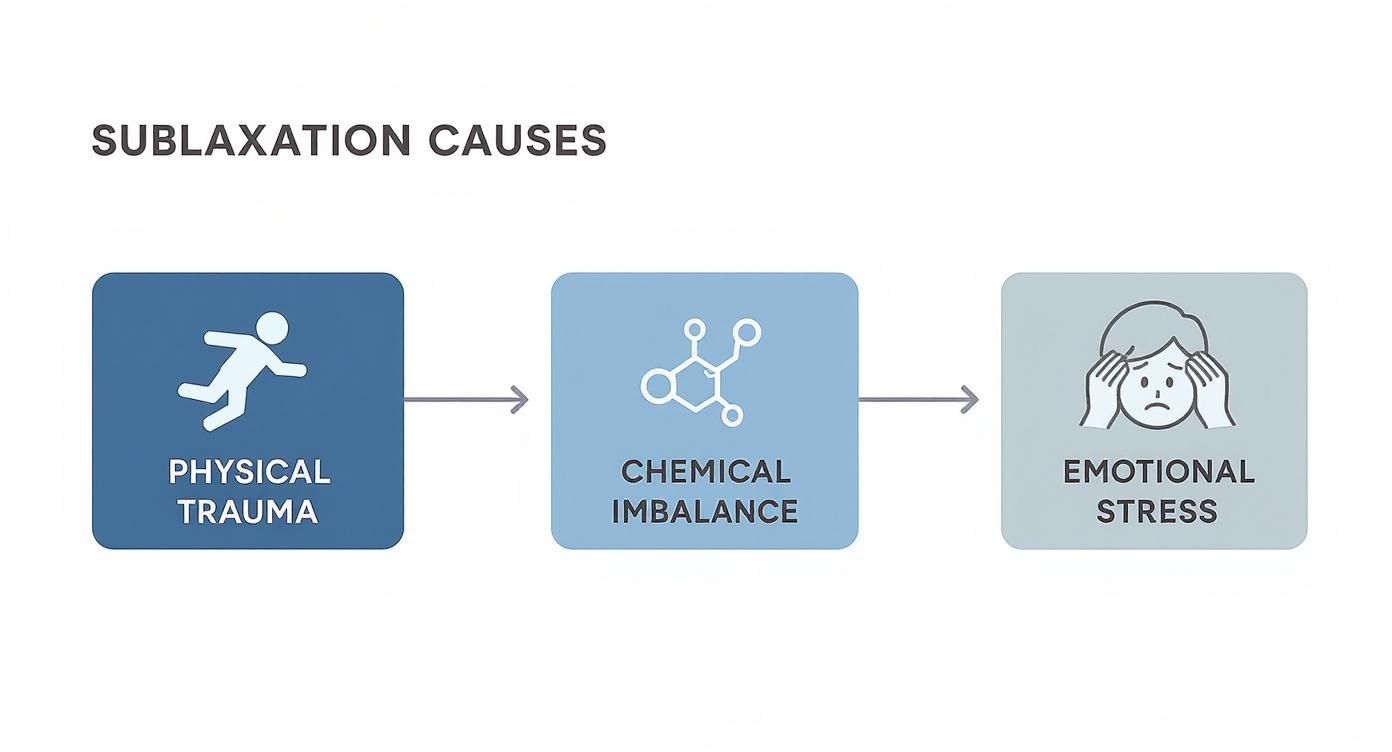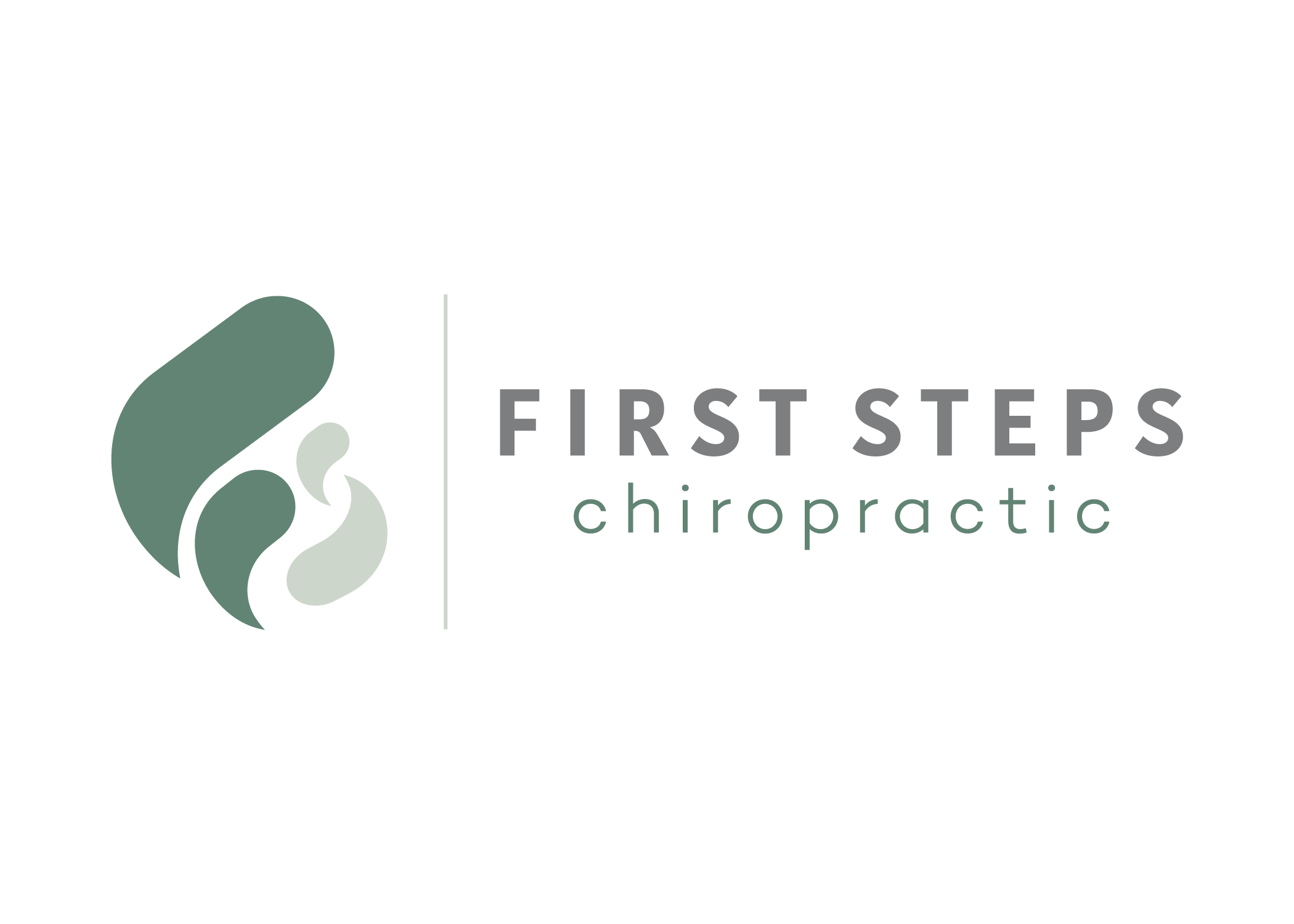So, what actually causes a subluxation?
The simplest answer is stress. But it's a bit more specific than just feeling overwhelmed. We're talking about three core types of stressors that knock your body out of balance: physical trauma, emotional tension, and chemical toxins. These are the big three that disrupt how your joints move and how your nerves communicate, leading to those subtle but impactful misalignments.
Unpacking the Primary Causes of Subluxations
Think of your spine like a finely tuned guitar. For it to play beautiful music—or in this case, for your body to function at its best—the strings need just the right amount of tension and must be in their exact positions.
If you drop the guitar (that’s physical trauma), leave it in a humid room (chemical stress), or wind one of the strings way too tight (emotional tension), it’s going to go out of tune. A subluxation is just like one of those out-of-tune strings. The joint isn't moving smoothly, and that messes with the "music," or the vital messages being sent through your nervous system.
This interference doesn’t always come from a big, obvious event. While major accidents can certainly be a cause, it's often the slow, steady drip of everyday life that plays the biggest role. Understanding this is the key to getting to the root of the problem, instead of just chasing symptoms.
The Three Pillars of Stress
To really get a handle on what causes subluxations, chiropractors break down these triggers into three distinct, yet often overlapping, categories of stress.
- Physical Stress: This category covers everything from the intense pressure of the birth process itself to a toddler’s tumble on the playground. It also includes bigger things like a car accident, but don’t forget the repetitive strains, like hunching over a laptop day after day.
- Emotional Stress: When you’re dealing with constant worry, anxiety, or frustration, your body physically reacts. Your muscles, especially in your neck and shoulders, clench up. Over time, this chronic tension can literally pull your vertebrae out of their proper alignment.
- Chemical Stress: What you put into and on your body matters. Exposure to toxins in the environment, a diet that’s missing key nutrients, or even just not drinking enough water can create inflammation throughout your system. This weakens the very muscles and ligaments that are supposed to be holding your spine in place.
Primary Causes of Subluxations at a Glance
To make it even clearer, let's break down the three main types of stressors that lead to joint dysfunction and nervous system interference.
| Stressor Type | Examples and Mechanisms |
|---|---|
| Physical Stress | Includes birth trauma, car accidents, falls, poor posture, and repetitive motions. These events cause direct mechanical shifts in the spine. |
| Emotional Stress | Chronic anxiety, worry, and tension cause muscles to tighten, physically pulling joints out of their natural alignment over time. |
| Chemical Stress | Poor nutrition, environmental toxins, and dehydration create systemic inflammation, weakening the supportive structures around the spine. |
Each of these stressors can act alone, but more often than not, they team up, creating layers of dysfunction that contribute to subluxations.
For a deeper explanation of the "what," you can learn more about the chiropractic definition of subluxation in our detailed guide.
The Three Core Stressors Behind Joint Misalignment
To really get what causes a subluxation, we have to look past a single incident and see the whole picture. Your body is built to handle stress, but when it gets overwhelmed by too much, too often, it starts to get stuck. This overload usually comes from three different, but connected, types of stress.
I like to use the analogy of a bucket. A little bit of stress is no big deal—the bucket can handle it. But when stress from different sources keeps pouring in without a break, the bucket overflows. That overflow is when a subluxation can happen, interfering with the vital communication pathway between your brain and your body.

As you can see, physical trauma, chemical toxins, and emotional thoughts all pile up. This is why we have to look at all three to find lasting health and true healing.
Physical Trauma (The "T" in Thoughts, Traumas, and Toxins)
This is the one most people think of first. Physical stress covers everything from major impacts, which we call macro-traumas, to the small, repetitive strains we know as micro-traumas.
- Macro-Traumas: These are the big events—a car accident, a slip on the ice, or even the intense journey through the birth canal for a newborn. The force is sudden and powerful enough to nudge a vertebra right out of its proper alignment.
- Micro-Traumas: These are the sneaky ones that build up over time. Think about hunching over a laptop all day, sleeping with your neck twisted, or constantly lifting a toddler on the same hip. Each one seems minor, but add them up, and they slowly pull your spine out of place.
Chemical Toxins
What goes into your body has a direct effect on how it functions, right down to your spine. Chemical stress comes from things like inflammatory foods, environmental pollutants, medications, and even just being dehydrated.
When your system is in a state of chronic inflammation from a poor diet or constant exposure to toxins, the muscles and ligaments that hold your spine together can become weak and unstable. This makes your joints far more vulnerable to getting misaligned from even minor physical strains.
This weakened state essentially sets the stage for subluxations to occur more easily and makes them tougher to correct. It’s a huge reason why a clean diet and plenty of water are fundamental to spinal health.
Emotional Thoughts
Never, ever underestimate the connection between your mind and your body. When you’re dealing with chronic emotional stress—from work deadlines, family life, or general anxiety—your body physically responds. Your muscles tighten up, especially in your neck, shoulders, and back.
This isn't just a feeling of discomfort; that constant tension is physically pulling on your vertebrae day in and day out. Over time, this relentless muscular pull can misalign your spine just as much as a physical injury can.
The link is so strong that a 2020 study found that 79% of patients seeking chiropractic care had vertebral subluxations. Stress is a massive piece of the puzzle. Understanding this connection is key, and you can dive deeper into how chiropractic care impacts the nervous system in our related guide.
How Subluxation Risks Evolve Through Life
The specific things that cause subluxations aren't a one-size-fits-all problem. The stressors we face change dramatically as we grow, meaning what puts an infant’s spine at risk is a world away from the challenges facing a teenager or a senior.
Understanding how these triggers shift is the key to proactive wellness for your whole family, at every stage of life.
It all starts at birth. Even a seemingly smooth delivery puts a huge amount of pressure on an infant’s delicate neck and spine, which can be the source of their very first subluxations. As they grow into toddlers, the tumbles and falls that come with learning to crawl and walk introduce a whole new set of physical stressors.
The Teen and Young Adult Years
As kids hit their teenage and young adult years, the sources of physical stress shift again. Suddenly, they're dealing with sports injuries, the constant postural strain of “tech neck” from staring down at phones and laptops, and even the physical demands of their first job.
These activities introduce new repetitive strains that their bodies aren't used to.
A traumatic shoulder subluxation is a perfect example of a risk that peaks during this active phase. Research shows a clear spike in these injuries among young adults, particularly males aged 20–29 involved in contact sports. You can learn more about the data on shoulder subluxation causes.
These formative years really set the stage for long-term spinal health, making it a critical time to address alignment before issues become chronic.
Adulthood and Senior Years
Once we reach adulthood, the cumulative effect of years of poor posture, sedentary desk jobs, and all those little unaddressed micro-traumas starts to catch up with us. Our body’s ability to adapt and bounce back isn't what it used to be, and degenerative changes can make our joints much more susceptible to misalignments.
For seniors, the risks evolve yet again. A natural decrease in muscle tone, balance, and bone density makes falls more likely—and a fall can cause significant spinal trauma and subluxations.
Each stage of life brings its own unique set of challenges, which is why ongoing spinal care is so important for maintaining function, mobility, and a great quality of life.
Recognizing the Warning Signs of a Subluxation

Think of subluxations as quiet communicators. Long before you feel sharp, undeniable pain, your body often sends out subtle whispers—signals that are incredibly easy to shrug off as just stress or the normal aches of daily life.
Learning to tune into these early signs is the key to catching a small issue before it escalates into a much bigger problem. And these symptoms aren't just about localized pain; they often show up in ways you might not expect.
Beyond Simple Stiffness
One of the most common early clues is a nagging, persistent stiffness in your neck or back. Maybe turning your head to check a blind spot while driving feels a little tighter than it used to. Or perhaps bending over to pick something up just doesn't feel as fluid as it once did. That’s your body talking.
This loss of mobility often comes with recurring muscle spasms or a feeling of weakness around a particular joint. It’s almost as if your muscles are working overtime, constantly guarding an area that isn't moving right, which naturally leads to fatigue and that familiar tight feeling.
Another huge red flag involves your nerves. Because subluxations can interfere with crucial nerve pathways, you might start experiencing symptoms that seem completely unrelated to your spine, such as:
- Tingling or numbness that runs down your arms, hands, legs, or feet.
- Recurring tension headaches that seem to originate from the base of your skull.
- Unexplained dizziness or sinus issues, which can often be traced back to misalignments in the upper neck vertebrae (C1 and C2).
A misaligned vertebra in your neck can disrupt the nerve signals and blood flow to your head, leading to a surprising range of symptoms. What feels like a simple headache could actually be your body’s way of signaling a deeper structural issue that needs attention.
Ultimately, these signs are your body's request for help. By listening to these early warnings and seeking a professional opinion, you can address the root causes of subluxations and restore proper function before minor issues become chronic problems.
Lifestyle Adjustments to Prevent Subluxations

While we can’t stop every unexpected fall or accident, we have far more control over the daily habits that build our body's resilience than we might think. Making proactive lifestyle adjustments is your best defense against the micro-traumas and chronic stress that lead to subluxations. It’s all about building a solid foundation for long-term spinal health.
Think of your spine as a crucial structure that needs consistent, daily maintenance. Small, intentional efforts to improve your posture, movement, and stress management can make a massive difference in how your body handles life’s physical demands. This isn't about a radical overhaul overnight, but about weaving smarter habits into your existing routine.
For example, simple ergonomic tweaks at your desk—like setting your monitor at eye level or using a chair with proper lumbar support—can dramatically cut down on the constant strain on your neck and low back. This alone can prevent some of the most common causes of subluxations.
Building a Stronger Foundation
Strengthening the muscles that support your spine is a non-negotiable step in preventing misalignments. A strong, stable core acts like a natural corset, protecting your vertebrae from excessive stress during all your daily activities. Adding exercises that focus on core stability is an absolute must.
To get started, you can explore our guide on how to strengthen core muscles for some practical and highly effective exercises.
Beyond exercise, mastering proper lifting mechanics is essential. Always lift with your legs, not your back, and keep heavy objects close to your body. This one simple technique properly distributes the load, shielding your spinal joints from sudden, damaging forces that can easily cause a problem.
Proactive care and smarter daily habits are true game-changers. While global data shows a decline in traumatic dislocations due to safety improvements, the rise in chronic issues from lifestyle factors underscores the need for prevention. You can discover more insights about this trend and learn about the findings on joint health.
Finally, don't forget about managing emotional stress. Techniques like deep breathing, meditation, or even a regular walk can release the built-up muscle tension that silently pulls your joints out of alignment.
A Few Common Questions We Hear About Subluxations
As we wrap up our conversation on what causes subluxations, let's tackle some of the most common questions people ask. These straightforward answers are designed to help you connect the dots between the causes and the care you might need, so you can feel confident about your health decisions.
Can a Subluxation Heal on Its Own?
While the human body has an amazing ability to adapt and can sometimes compensate for a minor misalignment, a true subluxation rarely fixes itself completely. What usually happens is the body goes into protection mode, creating muscle guarding and inflammation around the joint.
This response is helpful at first, but if the underlying issue isn't corrected, it can lead to chronic pain, stiffness, and even long-term damage to the joint. That’s why professional care is so important—to restore proper alignment, calm down the nervous system, and let your body truly start healing.
What Is the Difference Between a Subluxation and a Dislocation?
The easiest way to think about it is in terms of severity. A dislocation is a total separation of the bones in a joint. It’s usually caused by a major trauma, is incredibly painful, and is considered a medical emergency that needs immediate attention to put the joint back into place.
A subluxation, on the other hand, is a much more subtle misalignment. The bones are still in contact, but the joint isn’t moving the way it should, which creates interference in nerve communication. It might not be as dramatic as a dislocation, but over time, a subluxation can lead to significant pain and nervous system dysfunction.
A dislocation is a structural emergency, like a blown fuse in your house. A subluxation is more like a dimmer switch that’s stuck on low—the power is still on, but everything is functioning at less than its full potential.
Is Cracking My Own Back the Same as an Adjustment?
This is a great question, and the answer is a definite no—they are completely different things. When you "crack" your own back or neck, you’re usually just moving the joints that are already mobile and easy to pop. While it might feel good for a moment, doing this repeatedly can lead to hypermobility and make your spine less stable in the long run.
A chiropractic adjustment is a precise, controlled force applied to a specific joint that is “stuck” or misaligned. The goal isn't the popping sound; it's to restore proper motion to a specific segment of your spine. It takes years of training to learn how to identify and correct these fixations safely and effectively.
At First Steps Chiropractic, we specialize in finding the root causes of subluxations and providing gentle, specific care for your entire family. If you have more questions or are ready to see how chiropractic can help, we invite you to schedule a consultation. Learn more and book your visit at https://firststepschiropractic.com.

